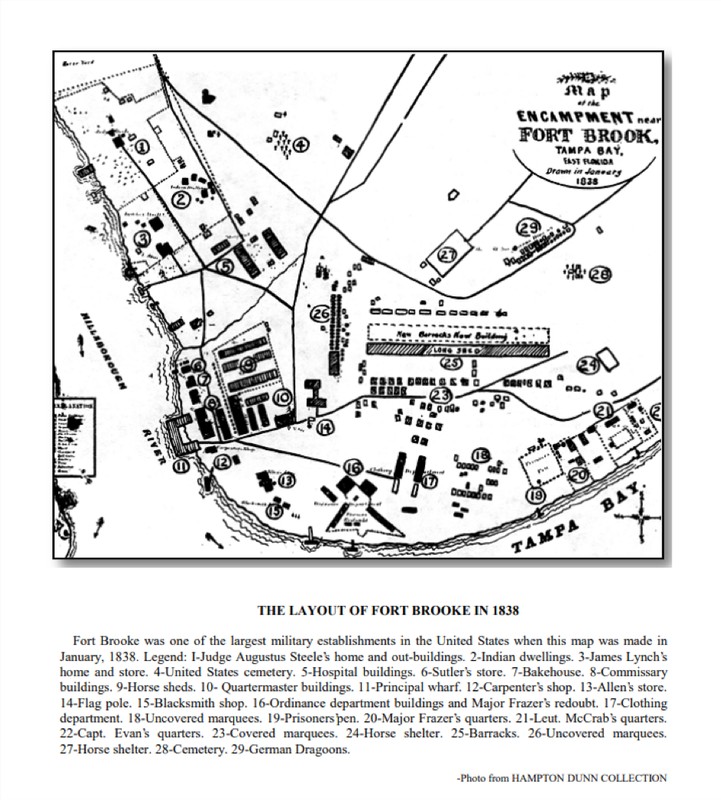Fort Brooke
Introduction
Text-to-speech Audio
Fort Brooke was built at the mouth of the Hillsborough River, by Colonel George M. Brooke, in 1824. According to the American understanding of the terms of the Treaty of Moultrie Creek (1823), the Seminoles lost the right to stay in this area. The US Army established the fort to enforce this provision. Fort Brooke played a significant role in the Second Seminole War (1835-1842). It was not only the December 1835 departure point for Major Dade’s command, whose ambush marked the beginning of the war, but it was also the principal port where Seminoles started their forced relocation to Oklahoma (the Trail of Tears). Fort Brooke played a role in the Third Seminole War but saw little action during the Civil War. The U.S. Army decommissioned the fort in 1883, and it was opened for homestead applications. Today, there is nothing left of the fort. In the 1980s, during the building of a parking garage in Tampa, the site was excavated leading to the discovery of artifacts and remains of US soldiers and Seminoles.
Images
Fort Brooke Layout (1838)

Backstory and Context
Text-to-speech Audio
Fort Brooke was established after the Moultrie Creek Treaty was signed in 1823. In this treaty, the Seminole had agreed to move into a reservation located in the central part of Florida. Colonel James Gadsden, who was one of the agents who signed the treaty for the United States government, was doubtful that the Seminole would respect it and pushed for the establishment of a military post in the Tampa Bay area, so the United States could demonstrate “power and disposition to compel obedience.” On November 5, 1823, the Adjutant General Office issued an order to Colonel George M. Brooke to secure a military post with four companies of the 4th infantry at the mouth of the Hillsborough River.
The four companies established the fort without issues. The health conditions were good, and each company cultivated a large garden. Colonel Brooke, however, noted that the Seminoles grew more and more displeased at the treaty and frequently trespassed across the reservation lines. He expected some difficulties to come and informed his superiors that there always should be a sufficient active force at the fort in the event of hostilities.
Neither side fully observed the Moultrie Creek Treaty. Tensions between the Seminoles and white settlers kept on growing. Finally, on December 23, 1835, Major Francis L. Dade with one hundred and ten men left Fort Brooke heading to Fort King (modern-day Ocala). The troops walked along the King Highway for three days, passing through Seminole territory. On the morning of December 28th, the Seminoles ambushed and killed all but three men of Dade’s command. Two men, including private Ransom Clark, managed to walk back to Fort Brooke and to inform the army of the battle. This event marked the beginning of the Second Seminole War which lasted for seven years. During this conflict, about 3,000 soldiers were stationed at Fort Brooke, and the location served as the major military outpost on Florida’s west coast. It not only received supply and troops, but its port also served as a deportation hub for the Seminoles’ relocation journey. They traveled across the Gulf of Mexico to New Orleans and then to Oklahoma. The Second Seminole War turned out to be the deadliest and the costliest Indian war the United States ever fought; 1,468 soldiers and countless Native Americans lost their lives. Without any clear victory, on August 15, 1842, the United States declared the war to be over.
After the war, the army did not maintain Fort Brooke well, and in October 1848, a hurricane leveled most of the buildings. The fort was then reduced in size, but it remained open and served again as a headquarters for Indian emigration, especially during the Third Seminole War (1855-1858).
During the Civil War, the Confederates occupied Fort Brooke. It only briefly saw combat in October 1863, when two Union ships bombarded it. Following this attack, the Union troops burned two boats, and a small inconclusive skirmish ensued. After this encounter, the Union troop left the area but returned and captured the fort and Tampa on May 6, 1864.
For the four years after the conclusion of the War, the United States Army used Fort Brooke as a military base to control the Tampa area. They also leased part of it, including the pier, to James McKay, a cattle rancher.
Conditions in the fort deteriorated, but in spite of this neglect, in 1877, troops stationed at Key West used the buildings to avoid a Yellow Fewer epidemic. The last roll call of soldiers occurred in 1882, and in 1883, the U.S. Army decommissioned Fort Brooke. About 20 soldiers buried in the adjacent cemetery were transferred to Barrancas National Cemetery, Pensacola, and then the Federal Land Office opened the space covered by the fort to homestead applications.
In 1885, Fort Brooke was incorporated as a town, but it was annexed by Tampa twenty two years later. Today, there is nothing left of the fort, only two historical markers: one which locates the Officers’ Quarters and one which marks the cemetery. This cemetery was rediscovered in 1980 when the city built a parking garage at the location. The bodies of one hundred and two soldiers and civilians were moved to Oaklawn Cemetery, and forty-two Seminoles were returned to the Seminole tribe.
Sources
Brooke, George M. and Covington, James W. The Establishment of Fort Brooke: The Beginning of Tampa. Florida Historical Quarterly, Vol 31, No. 4 (April 1953). 273-278.
Covington, James W. The Final Years of Fort Brooke. 1981. Sunland Tribune, Vol. 7, Article 8 https://pdfs.semanticscholar.org/cd07/f4a86a7cc772ceafc4bfaa0294cd9a30bfa1.pdf.
Covington, James W.The Hackley Grant, The Fort Brooke Military Reservation and Tampa. 1980. Sunland Tribune, Vol. 6, Article 2. http://scholarcommons.usf.edu/cgi/viewcontent.cgi?article=1040&context=sunlandtribune.
"Historical Marker dedicated to the Fort Brooke Cemetery." Fort Brooke Cemetery. https://fcit.usf.edu/florida/flassets/content/6700/fa6738/fa6738.htm.
Lewis, Aaron. "Battle of Fort Brooke and Ballast Point." Tampa Historical. http://tampahistorical.org/items/show/54?tour=5&index=6.
Hampton Dunn Collection
